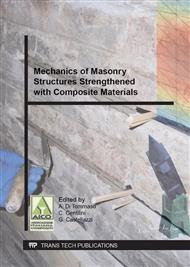p.254
p.266
p.275
p.283
p.291
p.299
p.307
p.313
p.322
Freeze-Thaw Durability of PVA Fiber Reinforced Mortars Representing In Situ Conditions
Abstract:
Polyvinyl Alcohol (PVA) fiber reinforced mortars (FRM) have been shown to increase the ductility of unreinforced masonry walls thus improving their out-of-plane flexural capacities. As these mortars become increasingly popular, their durability under freeze-thaw conditions requires further scrutiny. Previously, the durability of PVA FRM has been evaluated as mortar components only and not in combination with masonry units. The freeze-thaw testing of masonry mortars requires a complex analysis to duplicate in-situ conditions. Accelerated testing conditions are desired to represent the weathering that a structure would endure over time. This is done by simulating an aggressive weathering pattern on a test specimen in order for the analysis of the durability of the mortar and brick to be obtained within a timely manner. Currently, the standard freeze-thaw durability testing method for cementitious materials utilized in the United States of America, ASTM C666/C666M-03, is characterized by two methods: rapid freezing in water and thawing in water; and rapid freezing in air and thawing in water. This testing method provides a durability rating for specimens created and contained within a laboratory, but does not accurately represent all of the environmental factors that influence the durability of a mortar/brick structure. In this study, in order to replicate in-situ conditions, PVA FRM test specimens are constructed and subjected to freezing in water on only one side and are enclosed in a plastic bag to remedy the effect of the dry, frozen air reducing the moisture content of the mortar. Furthermore, the test specimens are frozen and thawed in a controlled environmental chamber where the relative humidity is controlled to prevent moisture change within the specimen. This enables rapid thawing of the specimen while controlling the relative humidity to better represent the in situ characteristics of masonry structures. The specimens are then subjected to 300 freeze-thaw cycles and evaluated to determine their degradation over that time. Results of the testing show limited reduction in material volume and weight of the PVA FRM compared to control samples that do not include PVA fibers.
Info:
Periodical:
Pages:
291-298
Citation:
Online since:
September 2014
Authors:
Keywords:
Price:
Сopyright:
© 2015 Trans Tech Publications Ltd. All Rights Reserved
Share:
Citation:


